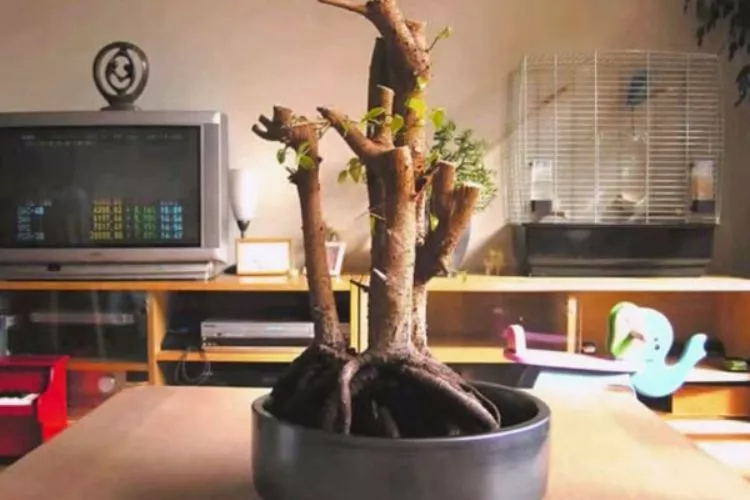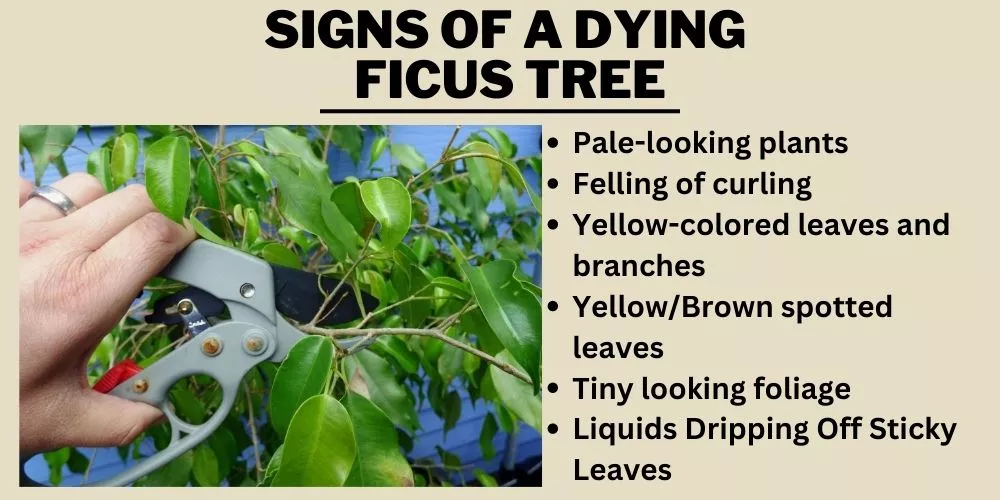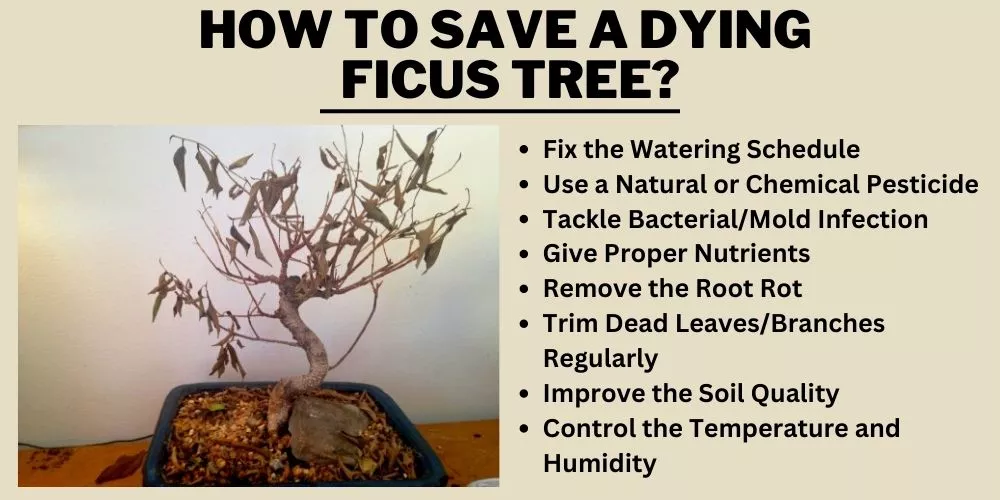The humble ficus tree (a.k.a. The weeping fig) is known for its timeless non-altering characteristics. Meaning they look almost the same regardless of their age.
This makes them great for a bonsai or a space filling plant for larger indoor areas. This charming houseplant is pretty straightforward to grow and maintain.
But, do you know how to save a dying ficus tree?
It’s important to learn the art, because a couple of factors may cause serious damage or even kill them if not applied correctly. The biggest culprit is improper watering which a poor choice of soil can compound. Another aspect is inadequate sunlight.

Whatever the reason, they can be fixed with simple adjustments or treatments. In this article, we’ll identify if your ficus is dying and how to save them if they are heading in that direction.
Table of Contents
Can You Save a Dying Ficus tree?
The ficus tree is popular due to its lush green leaves and extensive growth. If these particular plant species are grown in optimal conditions, they can last for as long as 20 years.
However, poor maintenance can slowly push them to breaking point.
When this occurs, they look pale, curl over, and become discolored before wilting and dying. As long as you see the warning signs early on, there’s usually hope for the survival of your ficus. The key point to correcting any health issue of rapidly deteriorating plants is distinguishing the root cause (mind the pun).

The most crucial part of a plant is its root system. If the root system is in good health, then the rest of the plant should recover, even if quite a bit of damage is caused above the soil.
Signs of a Dying Ficus Tree
Given that ficus trees are generally easy to maintain, growers get quite used to their lush green foliage. However, when a plant of this nature becomes stressed and goes unnoticed, it will transform away from its vibrant colors.
Let’s look at some signs that a ficus tree will present as they slowly deteriorate before, unfortunately, dying.

Pale-looking plants
When a ficus doesn’t receive enough light, it will start to fade in color and become spindly. This is one of the early signs of plant illness. Even any new growth will sprout out in lighter shades of green. Moving the plant to an adequately lit location can help it recover quickly.
Felling of curling
There are several reasons a ficus plant leaves can start curling up and felling (a.k.a. abscission). The phenomenon can occur when low humidity, improper watering, pests, and temperature changes are present.
Yellow-colored leaves and branches
When the leaves and branches of a ficus tree start to turn yellow, it’s usually caused by water stress or low humidity. It’s mostly present in indoor plants during the wintertime when the indoor air is slightly drier from the heating systems being turned up.
Yellow/Brown spotted leaves
The main cause of yellow or brown spotted leaves is related to anthracnose (fungal disease). This can be a result of one or many different infections.
Tiny looking foliage
Shrinking foliage comes from overall malnourishment. A range of things can cause this. For example, overwatering can suffocate the roots and not allow them access to oxygen nutrients which essentially stunts their growth.
Furthermore, poor soil conditions can amplify this situation. Insufficient light restricts the plants’ ability to photosynthesize, which is a process used to obtain energy.
Liquids Dripping Off Sticky Leaves
This sticky substance, honeydew, is generally secreted by one or multiple invading insects such as spider mites, scale, or mealy bugs. It’s essentially the waste product of these sap-eating insects.
Once they establish themselves, they are very tricky to control and remove. They suck the life out of plants when they sense an excess moisture content, such as when overwatering occurs.
How to Save a Dying Ficus tree?
When a ficus tree starts to show worrying signs that it is slowly dying, it’s best to keep a close eye on them. Try to distinguish the root cause by going through a process of elimination and ask yourself a few questions. Start by looking at the tree’s overall condition.
Is it weeping and looking limp or even dropping its leaves? Then move on to the leaves themselves. Do they contain a sticky honeydew substance?
Are they revealing spots or starting to become discolored? Move onto the stem and check on its stability.

Finally, test the soil condition and even pull the tree up to check on the root system. Is the soil claggy, or are the roots showing any signs of rot? If one or even a number of these signs are present, you can make some of the following adjustments to correct the issue.
Fix the Watering Schedule
The ficus tree enjoys a moderate amount of moisture during its season of growth. In contrast, they require almost no watering during the winter, when they go semi-dormant. Aim to keep the soil moist without soaking it.
One of the best methods includes watering and allowing the top 2-3 inches to completely dry out before watering again.
This may mean that your water then sticks stick your finger down into the container and checks for moisture. The drying out period could take anywhere from 1 day to 3-4 days, depending on various environmental factors.
Overwatering a ficus will lead to root rot which will attract insects and cause more issues as they begin to establish themselves. Poor soil characteristics will also cause overwatering to amplify.
Use a Natural or Chemical Pesticide
When it comes to smaller, crawling, or flying, plant invaders, we always recommend using natural products on any of your plants.
One of the easiest methods is using basic staple items such as natural dish soap and water. Simply mix 1 or 2 teaspoons of soap into 1 gallon of water, and add the mixture to a spray bottle.
Spray it onto the ficus leaves and allow 24-48 hours to see the results. If the issue isn’t resolved after the first application, rinse and repeat until they are all gone.
This mixture will help to treat aphids, mealybugs, scale insects, and spider mites. If you don’t mind using chemicals, then either Actara (thiamethoxam), Confidor 79WG (Imidacloprid), and Renounce (Bifenthrin) are great options.
Tackle Bacterial/Mold Infection
Fungal diseases such as Botrytis Cinerea, Phomopsis, Anthracnose, Xanthomonas, or any Insect-borne Diseases can be extremely dangerous to a ficus tree, if spotted early enough, they can be remedied using both natural and chemical based fungicides.
But first, you may need to prune away any severely affected limbs. Remember to discard any foliage tainted with care to avoid spreading. Then go ahead and treat the areas once cleaned up. If natural is your thing (which it should be), you can use baking soda and water.
This can be done by mixing about 4 teaspoons or 1 heaping tablespoon of baking soda (20 mL) with 1 gallon (4 L.) of water. Add the solution to a spray bottle and spray the affected area.
Always test the mixture on a small area of the plant before using it. The best chemical based formulas are copper-based foliar fungicides.
Give Proper Nutrients
Ficus trees should not be overfed to save them. However, a regular feeding schedule will encourage growth all year round.
They should be given a well balanced, all-purpose, 8-8-8 fertilizer. (8% nitrogen, 8% potassium, and 8% phosphorus). These can be administered monthly during growth periods (spring- summer) and backed off to once every second month in nongrowth periods (fall-winter).
Remove the Root Rot
Any visible root rot should be removed as cleanly as possible with sterilized pruning tools such as sheers or gardening scissors. This requires uprooting the tree and gently removing the soil.
Then, cut away any decaying roots to reveal only clean, healthy ones. Once clean, apply a good quality fungicide before repotting the tree and nursing it back to health.
Trim Dead Leaves/Branches Regularly
Ficus trees grow wild, especially when exposed to a consistent amount of indirect but bright sunlight. Consequently, they need a little extra maintenance to shape them and allow other areas to receive exposure. It’s often the case that the outer leaves block the inner and lower leaves from growing.
Therefore, pruning them back to allow internal growth is essential. Removing any dead or decayed branches is also good practice to encourage new growth. The tree will stop using its energy to revive those limbs and focus on new ones instead.
Improve the Soil Quality
Soil quality and characteristics are always important for any plant; these wonderful trees are no different. A ficus needs soil that is well draining and fertile. This helps prevent overwatering, which brings on root rot and insect infestations as a result.
The best soil types for these characteristics include rotted compost or sheep dung. Try to keep the pH between 6.0 and 6.5 (slightly acidic) for optimal results.
Control the Temperature and Humidity
Ficus trees thrive best when placed in the 60- 80°F (15.5-27°C) range. Try to keep them away from draft prone areas or doorways. They also enjoy humidity levels that balance between 40%-60%. It’s possible to boost the area’s humidity with small in-room humidifiers or even humidity trays.
A Few Additional Tips
Aside from the above solutions that can help save a dying ficus tree, there are a handful of other tips worth noting. These include:
Light, light, light!
These plants adore the sunlight. They require at least 6 hours of indirect sunlight per day. Furthermore, the fact that they grow so fast means that their outer foliage can easily restrict the inner and lower areas of the plant from growing. Therefore, it’s a good idea to spin them around just slightly once per week in the same direction.
Trim to reveal
If you are lucky enough to have an abundance of light shining on one of these trees, then you will see how busy they can get. If you’re trying to keep it compact, it’s wise to periodically prune the outer section.
This will help the light to reach the inner and lower sections and give them a well received boost in growth. It will also encourage healthy regrowth, which is optimal for all growth facets.
Supply and Demand
Finally, try to keep an eye on your ficus and look for visual cues. Simply give the plant what it needs. Check the moisture content and apply accordingly. If it’s fading, relocate it. If insects are attacking, wipe them out! A healthy tree will take in nutrients, soak up water, oxygen, and light much more efficiently than an unhealthy tree.
Frequently Asked Questions (FAQs)
Do ficus like to be misted?
Ficus trees thrive in humid conditions, so misting is a great way to regulate the balance. High humidities can also be achieved by placing the plant on a pebble tray filled with water. This concept prevents the plant from submerging its roots in water, allowing the misting process to take effect much faster.
What is the lifespan of ficus trees?
A well maintained ficus tree grown in an optimal environment with perfected conditions can live for up to 20 years.
Do ficus trees like sun or shade?
Ficus trees love sunlight. Giving them at least 6 hours of bright but indirect sunlight daily will keep them happy for the rest of their lives. Shading them will stunt their growth.
Conclusion:
Ficus trees are known to bush out and flourish when provided with all their essential growing conditions. One of the best ways to mitigate any damage caused to them by environmental stress is by watching for signs.
Curling, felling, discoloring, spotting, and sticky liquids should all be noted and corrected as soon as possible.
A healthy ficus tree will provide any room in your home with a beautiful backdrop. We hope that this guide has been helpful. You can read about similar topics here on our website. Check back again soon for more.


